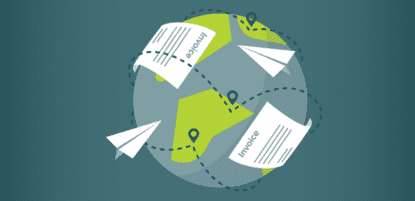There are many reasons to say goodbye to B2B check payments. It’s a manual, paper-based method that’s been around for at least hundreds of years, if not longer. Some historians credit the invention to the Romans in the mid-300’s B.C., but it began to catch on in the 1500’s in Holland, and became an established form of payment in the U.S. in the 1680s.
Any way that you look at it, checking is an outdated, time-consuming, and expensive system that wasn’t designed for the business requirements of the 21st century. In today’s real-time marketplace, checks can take days or longer to issue and be received, often resulting in payment delays.

While companies have been dealing with the problems associated with check payment for a while, the COVID-19 pandemic has pushed them over the edge. Many AP/finance teams have had to go to incredible lengths to get physical checks prepared, signed, and sent as work-from-home became the norm. One AP manager had to go into the office to print a batch of checks, which he sent via FedEx to a CFO to sign, who in turn, sent them back through overnight delivery to the AP manager to individually send out. It’s not only extremely inefficient, but it’s exhausting just to think about.
Checks are also very vulnerable to fraud. According to the 2020 AFP Payments Fraud and Control Survey Report, check payment was the leading method associated with fraud, impacting 74% of respondents.
For all these reasons and more, companies are now comparing ACH, checks, and virtual cards to determine which payment method makes the most sense for them. Many businesses have made the decision to say goodbye to checks and move to an electronic form of payment.
So, the question becomes, where do you go from here? While you might think ACH is the next logical step, it’s time to reconsider that approach.
ACH vs. Virtual Cards
Although around for not nearly as long as checks, ACH is hardly a modern technology, having been introduced about 50 years ago. While this electronic payment method can help organizations reduce manual tasks and gain some efficiency compared to checks, it is an increasingly outdated option in the automation process. In fact, virtual cards are a more efficient and secure solution. So, why pursue a dead-end in electronic payment processing, when you can easily leapfrog to more future-proof, efficient automation?
Here are 5 reasons you might consider converting your payments directly to virtual cards, instead of ACH:
- ACH involves more work. With ACH payments, companies are required to collect and store vendor information. In addition to being responsible for maintaining the security of the data, you have to spend time calling all your vendors to collect banking information and enroll them in the system. And that’s not a one-time thing–every time you get a new vendor, you have to go through the process again. By contrast, you don’t have to do any of this work with virtual cards since your payments provider will handle the logistics of the enrollment process. And, some providers can even handle it continuously, whenever new vendors come on board.
- ACH is prone to fraud. According to the AFP Fraud Survey 2020, 55% percent of companies were victims of actual or attempted ACH fraud in the previous year. When it comes to virtual cards, only 3% of companies reported actual or attempted fraud. Virtual cards provide the added protection of unique, randomly generated numbers designated for one-time use and for a specific payment amount.
- With virtual cards, AP can become a profit center. In addition to the efficiencies, convenience, and security that virtual cards provide, they offer companies cash-back rebate payments. You have less work, more efficiency – and you’re getting paid for it? It’s a no-brainer. In fact, for many companies, virtual card rebates exceed the cost of their AP automation solution, putting money in the company’s coffers to invest in other initiatives.
- Virtual cards offer benefits to vendors too. While vendors pay a fee to process card payments, they benefit from a faster, easier experience. ACH requires vendors to go to two places to find and match a payment with remittance data: the payment appears in the bank statement, while remittance information is in an email. With virtual cards, vendors get one email that includes both payment and remittance information.
Also, virtual cards provide vendors with immediate certainty that payment has been made and received. With checks, it can take days before payment is received, and payment through ACH, which is performed as a batch process, usually appears the next business day. - ACH can’t support payment on demand. Some companies demand payment at the time of service–e.g., for Google AdWords, Amazon Web Services and many other cloud services. It also became popular for healthcare companies and others to require immediate payment during the pandemic. This is not possible with ACH, but virtual cards can support that. As we continue moving to a real-time economy, that will likely become more prevalent.
Final Thoughts
ACH won’t totally go away. There will still be some vendors that require ACH payments, but a best practice is to move as many as possible directly from check to virtual cards. Also, if you know that you ultimately want to move to virtual cards, the time to do it is now because vendors may be more amenable to the idea given their own challenges processing paper checks during the pandemic. Moreover, like anyone else, vendors have to overcome inertia to change, and once settled with ACH, they may resist a future switch to virtual cards.
One thing is clear. It’s time to say goodbye to checks. If you move to modern, secure, and automated virtual card payments, you will enjoy significant benefits with little or no effort on your part.




